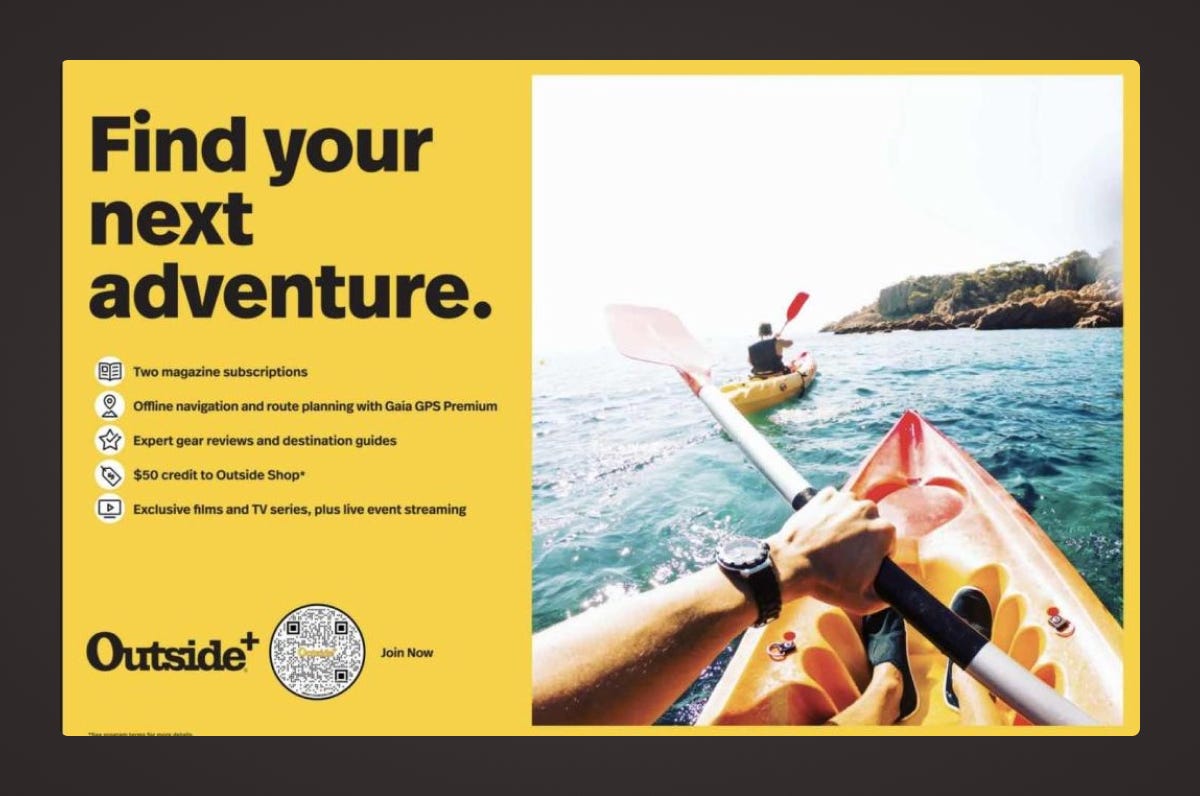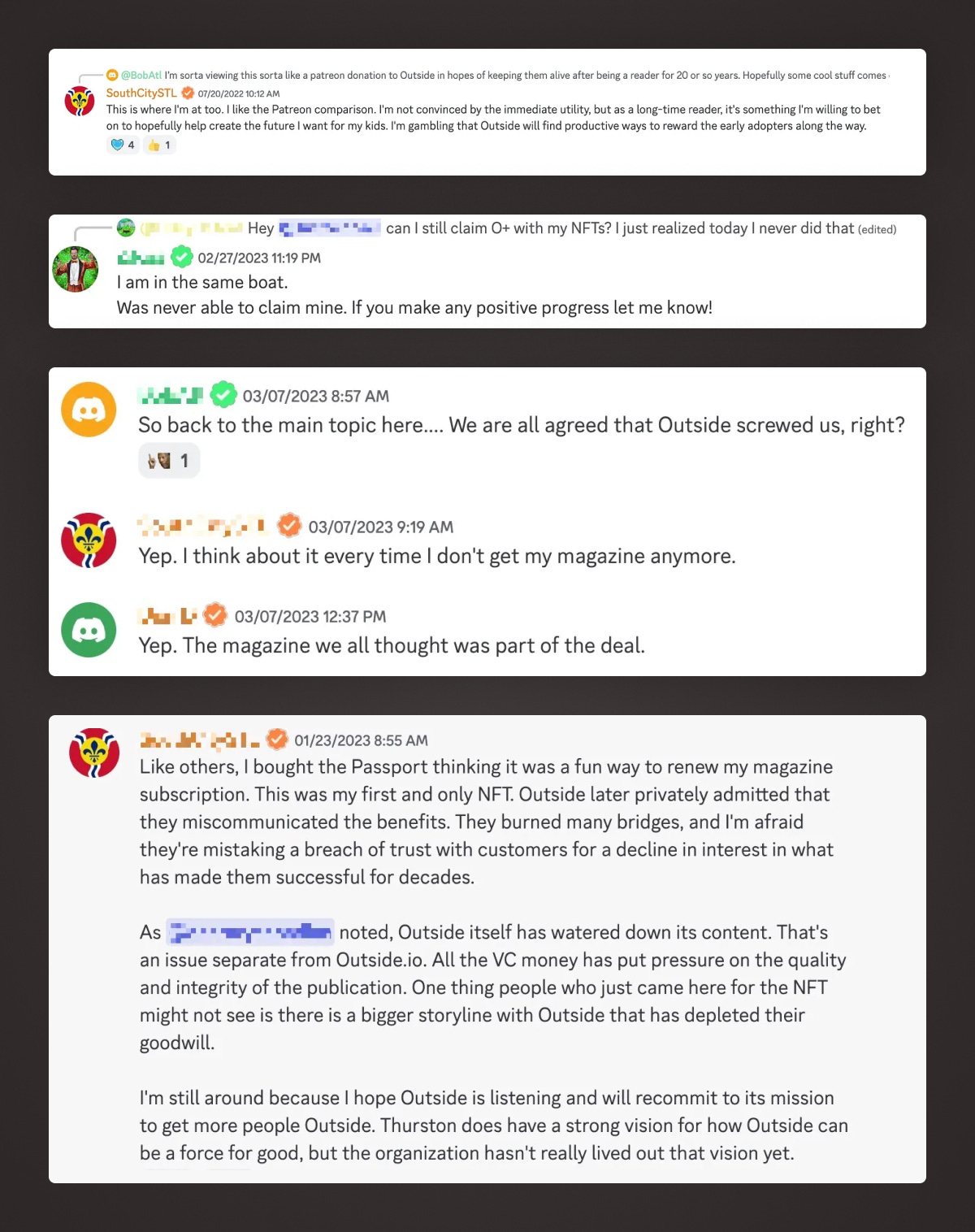Last year, in the wake of a series of high profile acquisitions, Outside launched an NFT initiative called Outside.io. Eight months later it was abandoned. This isn’t a story about NFTs, but it’s where we’re going to start.
April - Outside announces their Outside.io NFT initiative. Promises for initial NFT holders included: two print magazine subscriptions, two free books, free entry to Outside’s bike race series, free race entry credit elsewhere, discounts at the Outside shop, discounts at other events, and access to exclusive IRL events. They also promised to “…continually add benefits to the Outerverse Passport over the coming months and years, in order to ensure that our early community members are rewarded for supporting us from the start.”

**July - **Sales of the “Outerverse Passport“ go live. The launch is underwhelming and plagued with technical issues, primarily around the inability for folks who bought NFTs to properly claim the Outside+ memberships they were promised, and difficulty transferring their NFTs between wallets.
Confusion arises as the people realize that in between April and July, Outside quietly changed the definition of what Outside+ actually is. **When the benefits of the Outerverse Passport were communicated, “Outside+” included a range of things that had been eliminated by the time NFT sales went live. **

July - October - They give away some gear to NFT holders, have a special food event (which 1 community member is invited to), and continue dealing with a plethora of technical issues.
October - James Arnold Biking NFT drops. Again, it sees poor sales.
November - Additional layoffs and the “pausing” of Outside.io.
December/January - Unfulfilled promises of updates and then radio silence. There are still people who never received their 3 years of free Outside+ because of technical glitches and lack of response from Outside support.
At this point, Outside has completely abandoned hundreds of backers in the Outside.io community on Discord, and left them with unanswered questions, unanswered emails, no support, and no indication of what (if anything) comes next.
Before you say: “Serves them right, for buying into an obvious web3 scam”, I think it’s important to note that regardless of your thoughts on NFTs, there were a lot of folks involved who genuinely bought into the vision that Outside was promoting.

When I wrote about this project I ended my initial post with an open mind. I said: “I’m not rooting for anything to fail, and I’d be happy to talk to anyone with an open mind”. I had a conversation with an Outside VP in May where I surfaced my many concerns with the positioning and technical approach (he floated the idea of hiring me as a consultant, I didn’t pursue).
Unfortunately, based on the way they’ve abandoned their backers, it frames their motivations in the worst light possible…as a poorly executed, opportunistic money grab and opportunity to try and drive additional Outside+ customers. Many of these people feel strongly that Outside took their money and never delivered on the product/service they were promised. Some have never been able to claim the subscriptions that were promised due to poor support and technical issues. Others are less lucky, as the ongoing benefits of Outerverse NFT ownership are not guaranteed (as outlined in the terms).
But like I said, this isn’t about NFTs
I’ve worked in tech for a long time – not everything works. Initiatives fail, features fail, companies fail, and you move on. But the way you react to those failures and treat the customers involved says a lot about your company.
This isn’t about judging whether you think Outside.io was a good idea or not. I think this is really a story about the importance of community, respecting your members, and Outside’s recent treatment of various groups within their ecosystem. They sold the Outside.io community on a vision, and then were quick to toss those people aside when it became clear they couldn’t recoup their investment quickly. Who knows if the project will ever be re-visited, but they’ve effectively burned a lot of bridges.
Healthy communities aren’t things that just happen. They’re built on a shared set of goals, incentives, and trust between you and your members. If you don’t provide your community with value (in the form of content and/or experiences they want and trust), they will leave. David Spinks shared some great insights on community building in Lenny’s Newsletter.

Outside has a strong position in the outdoor industry, but it’s also a precarious one. Their dominance invites challengers to put wedges in the cracks around the edges of their foundation, using recent negative perceptions as a foil.
I’ve talked to multiple Outside advertisers who are still advertising within the ecosystem, but lament a recent decrease in quality and many feel like they “have to be there” rather than “want to be there”. Shared content across various Outside properties means a lack of control over gear placements and an increase in content catering to the lowest common denominator – often at the expense of more in-depth writing and gear pieces that reach sport or experience-specific audiences.
Poor handling of the acquisition and management of CyclingTips resulted in the launch of Escape Collective, an independent, member-supported cycling platform focused on quality journalism. With memberships for $99/year, you might say “Hey, that looks a lot like the Outside+ business model” – and you’d be right. There’s nothing inherently wrong with subscription models. The difference is that the folks behind Escape Collective have a community that is bought in to their vision, and trusts the people in charge to execute on that vision. Also, the new website is pretty rad.
Now, you don’t necessarily need a community to be successful. If the product is good (or convenient), people will still buy and use it. Outside has an audience of millions and in reality, most of them are probably unaffected by (or unaware of) the developments I’ve mentioned. I’ll acknowledge that my perspective is closer to that of an industry insider than a random Outside subscriber. However, the buy-in and trust that comes from an engaged community can be invaluable – especially if you’re planning on making big, sweeping changes (as Outside has been doing lately).
It’s not a problem limited to Outside. As companies grow it becomes increasingly difficult to maintain high levels of trust and community engagement, and I think we’re seeing similar shifts in a range of industries right now. Such is the cycle of building companies.
Strava —> Any Distance
Linkedin —> Read.cv, Polywork, niche communities like Lenny’s Newsletter or Basecamp Outdoor
Outside —> Mountain Gazette, Escape Collective, Substacks, more independent titles
Google Analytics —> Fathom
Facebook —> Verticalized social networks, Discord communities
In conclusion
Whatever your opinion on the Outside.io project, the way that it has been handled shows a troubling lack of respect for their customers. To completely abandon a community that multiple members of leadership touted as a major focus and direction for the company just weeks and months before is never a good look.
I’m not rooting against Outside. It’s an important part of the industry and is currently a key vehicle for outdoor and travel journalism. The recent staffing cuts and user base consolidation means their P&L sheet and vanity metrics likely look better than ever. Their subscriber numbers probably look amazing as Outside+ has subsumed Gaia GPS users. But…they’re starting to lose the trust of customers. I’m only an Outside+ member because my Gaia GPS subscription got automatically converted to one – right now it’s unlikely I’ll let that renew. If they want to pursue this outdoor super app/company/content/community concept that combines all kinds of engagement tracking/rewards/etc, that loyalty needs to be repaired.



